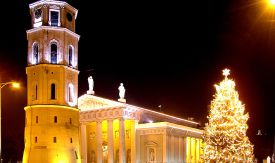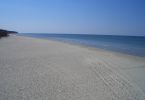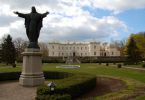
Vilnius Attractions.
Due to its unique historical and architectural features, the Old Town of Vilnius was declared a World Heritage Site by UNESCO in 1994. Like all other medieval cities, Vilnius developed around the Town Hall. The main street, called Pilies Street connected the Grand Ducal Castle and the Town Hall. Other winding streets of the city led to the mansions of the nobility and landlords, churches, small shops and craftsmen shops. Narrow winding streets and small cozy courtyards formed a radial plan of medieval Vilnius. The remains of the impressive medieval construction – a city wall of Vilnius (next to the Bastion, the Gates of Dawn) – can be still seen in several places. Multicultural, multinational Vilnius was referred to as the Jerusalem of Lithuania (Yerushalaiyme de Lita). People of different nationalities and creeds peacefully co-exited here, unfortunately, with the passing of time, only one Synagogue has survived out of Vilnius’ 105 synagogues. In the 16th century Vilnius became an important educational and cultural centre. Vilnius University established by the Jesuits is one of the oldest universities in Eastern Europe. The Old Town campus is arranged around thirteen courtyards, where you can, not only see impressive architectural elements, but also visit the Church of St John the Baptist and the Observatory.
Places Of Interest
The Old Town is the heart of the capital, its historical centre. In the early part of the 16th century, it was surrounded by a city wall thus defending the limits of the Old Town. There was a large complex of castles consisting of the Upper (on Gediminas Hill), the Lower (at the foot of the hill) and the Crooked Castle (on the adjacent hill), the Grand Ducal Castle, the Cathedral, the House of Bishops and other buildings. Life of the city was in full swing in the Town Square and the surroundings streets. Craftsmen’s shops, small shops, merchants’ houses, mansions of the nobility were situated there. Buildings and streets beyond the wall formed the suburbs. Today it is only in our imagination that we can reproduce such a picture… While wandering along the narrow winding streets and squares of the Old Town we can feel the spirit of the old town, seeing the authentic buildings or their fragments.
A Monument To Grand Duke Gediminas
Gediminas, Grand Duke of Lithuania who ruled from 1316 to 1341, is considered to be the founder of the city of Vilnius. The monument to him was created in 1996 from the design by the sculptor Vytautas Ka?uba.
Gedimina' Tower Of The Upper Castle
The Tower standing on the 48-metre high hill has been named after Grand Duke Gediminas, the founder of the city (though it was constructed long after the time of Gediminas. Gediminas’ Tower has become a symbol of Vilnius. People lived on the hill of the castle as far back as the 5th-6th century. A castle, which was last, rebuilt at the time of Vytautas the Great, Grand Duke of Lithuanian, stood there at the end of the 14th century. The castle used to consist of a keep surrounded by a wall with three separate towers and the entrance gate. Of the once powerful castle, the western (Gediminas’) tower that has been restored is the only surviving one, as well as the ruins of defensive wall that surrounded the palace and the castle. The first-floor room exhibition containing two models of the three castles, one as they were in the 14th century, the other in the early 17th century. They provide an interesting comparison, and show how the site developed, reflecting the history of Vilnius’ castles. However, the main attraction of the Gediminas’ Tower is the view from the roof. A narrow staircase leads visitors up to a parapet that overlooks the entire city centre. This is the best place from which to appreciate the breathtaking panorama of the city.
The Bastion Of Vilnius City Wall
The Bastion is an original Renaissance fortification. It consists of a tower installed in the city wall, the underground gun ports and a corridor connecting them, which becomes a 48-metre long tunnel. The Bastion was built in the first half of the 17th century, and you are rewarded with a stunning view of the Old Town from its terrace.
The Bell Tower Of The Cathedral
The bell tower stands on the remains of the fortifications of the Lower Castle. It is thought that the lowest round tier of the bell tower dates back to the second part of the 14th century, later the bell tower became a belfry. The next tier was built in the 17th century with the installation of the clock made in Germany by Joseph Bergman. The belfry acquired its present appearance at the beginning of the 19th century, and stands at a height of 57 meters.
The Cathedral
The first Christian church is thought to have been built in the place of a pagan temple to commemorate the baptism of Mindaugas, King of Lithuania, in 1251. Later the Cathedral was rebuilt several times, and fragments of different styles have survived up to the present time. The Classical feature of the Church is a result of the design by the Lithuanian architect Laurynas Stuoka-Gucevi?ius at the end of the 18th century. The interior of the building contains many valuable frescos, pictures, sculptures, and tombstones. The crypt contains an early fresco, The Crucifixion, the oldest wall painting in Lithuania (the end of the 14th century). St Casimir’s Chapel abounds with numerous frescos, decorative stucco works and sculptures – this is one of the most valuable examples of mature Baroque architecture in Lithuania. A silver coffin, made in the 18th century, holds the remains of St Casimir, Grand Duke and patron saint of Lithuania.
Three Crosses
Legend has it that in the 14th century, at the time of Duke Algirdas, seven Franciscan monks who arrived to convert Lithuanians to Christianity were hacked to pieces by pagans. The monks were buried on this hill, and then a chapel was built here, to be later replaced by crosses. The concrete crosses built in 1916 were destroyed by order of the Soviet authorities in 1950. In 1989 three white crosses shooting up to the sky were rebuilt.
The Ensemble Of The Church Of Saint Anne And The Church Of Saint Francis And Saint Bernardino
This is one of the most impressive architectural treasures of the Old Town of Vilnius. The Church of St Anne was built at the turn of the 15th – 16th centuries and is the most admired and beloved churches of late Gothic period in Lithuania. Built from ordinary clay bricks of 33 different shapes it amazes everyone by the courage and ingenuity of the masters who built it. It is the subject of a much-quoted remark, which is said to have been made by Napoleon when his army occupied Vilnius in 1812 that he would like to be able to place it in the palm of his hand and take it back to Paris. The Church of St Francis and St Bernardino was built at the end of the 15th century and is one of the largest Gothic religious buildings in Lithuania. Due to the fact that it was built at the same time as the city wall and is situated on the edge of the Old Town close to the River Vilnia, it is believed to have been later incorporated into the city’s defenses. It also contains battlements and loopholes. Following the changes that were made in the 16th-17th century, the Church acquired Renaissance and Baroque architectural features rendering it into a curious hybrid of styles. At the present time, the Church is undergoing restoration and archaeological examinations are being carried out there.
The President's Office
This building is of the late Classical – the empire style (the 19th century). From the time of Lithuania’s conversion to Christianity, in 1387, to the country’s annexation by the Russian Empire in 1795, this was the site of the Bishop of Vilnius’s palace. It was taken over as a residence by the Russian governor; and in 1812, when the French army marched through, Emperor Napoleon of France stayed here. In 1997 it was converted for use as the President’s Office.
Vilnius University
Vilnius University is situated to the West of Daukanto aik?t? and takes up a whole block in the Old Town between ?v. Jono, Skapo and Universiteto streets. The buildings are a collection of Gothic, Renaissance, Baroque, and Classical styles. The campus is arranged around twelve closed courtyards. The most prominent features of the Great Courtyard are the tallest Church of St John the Baptist and St John the Evangelist (the 14th – 18th centuries) and the tallest bell tower. Vilnius University is one of the oldest universities in Eastern Europe. The University started from a Collegium, which was established by the Order of the Jesuits who came to Lithuania to fight against the spreading Reformation. In 1579, Stephen Bathory, the elected King of Poland and Grand Duke of Lithuania, conferred on it the status of university. The Library of the University, established in 1570, stores especially rich collections of old and rare publications, the first printed books and maps.
The Town Hall
The first Town Hall was built in this place as far back as the 15th century. In its time the magistrate was housed here, the court held its sittings, the treasury, the archives, and arms were kept here. The present Town Hall was constructed at the end of the 18th century by the Classical architect Laurynas Stuoka-Gucevi?ius. The Town Hall Square has always been the economic, administrative and social centre of the city. Important trade roads led to the Square, which in turn became the streets of the city.
The National Museum
Another building, known as the Arsenal, whose north/south wall coincides with the former defensive wall of the Castle, houses the National Museum. Fragments of many styles of architecture can be found in this building, beginning with Gothic basements and ending with the classical fa?ade. Since the year 2000 the updated archaeological exposition Lietuvos proistor? (Prehistory of Lithuania) has been on display in one of the buildings of the Museum.
The Gates Of Dawn
The Gates of Dawn is the only surviving gate of the original ten gates in the city wall that was built in 1514. This is a three-storied Renaissance building. The entry, with a draw bridge over the defensive moat, was in its first storey. From the side of the town, on the upper premises of the gate, a wooden chapel was erected. Following the reconstruction in 1829 the Chapel of the Gates of Dawn acquired the shape of the later Classical period. The picture of the Holy Mother of God, which is thought to have miracle-working powers and which is one of the most significant Renaissance paintings in Lithuania, is stored in the Chapel. The picture was painted at the beginning of the 17th century by an unknown painter.
The Church Of Saint Peter And Saint Paul
The Church of St Peter and Paul is one of the most famous Baroque buildings in Lithuania. The building complex began in 1668. The interior of the Church is a masterpiece of Italian and local masters (the second half of the 17th century), a veritable pearl of Vilnius Baroque. The Church is an enormous theatre of figures and relief sculptures on every surface - the nave, the pulpit, the vaults, the dome, the walls and ceilings of the chapels. There are said to be over 2,000 human figures alone, in addition to the military emblems, flora, liturgical objects and various forms of abstract decoration.
The Church Of Saint Casimir
This is the first Baroque church in Vilnius. It was built by the Jesuits to commemorate St Casimir, patron saint of Lithuania. Work commenced at the beginning of the 17th century, after St Casimir had been canonized. In 1832, the Church was turned into a Russian Orthodox Church. In Soviet times the Museum of Atheism was opened there but in 1991 the Church of St Casimir was restored as a Catholic Church.
Orthodox Church Of The Holly Spirit and Vilnius Orthodox Monastery
This is an early Baroque building (the first half of the 17th century), with a Rococo style interior. In the 18th century, after the fire, the house of worship was rebuilt and acquired its present appearance. Of enormous value is a large iconostasis luxuriously decorated with a marble imitation and painting. An orthodox monastery and convent are currently located at the Orthodox Church.



